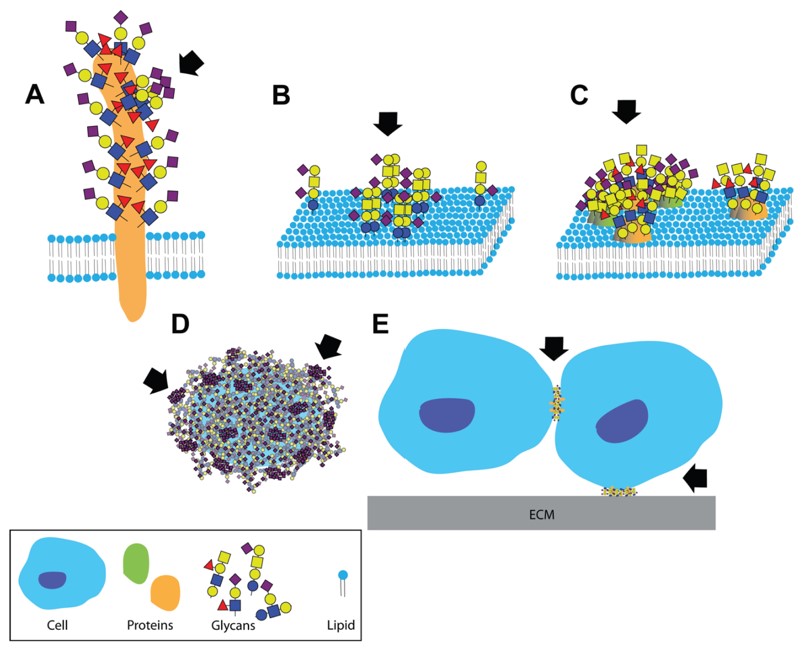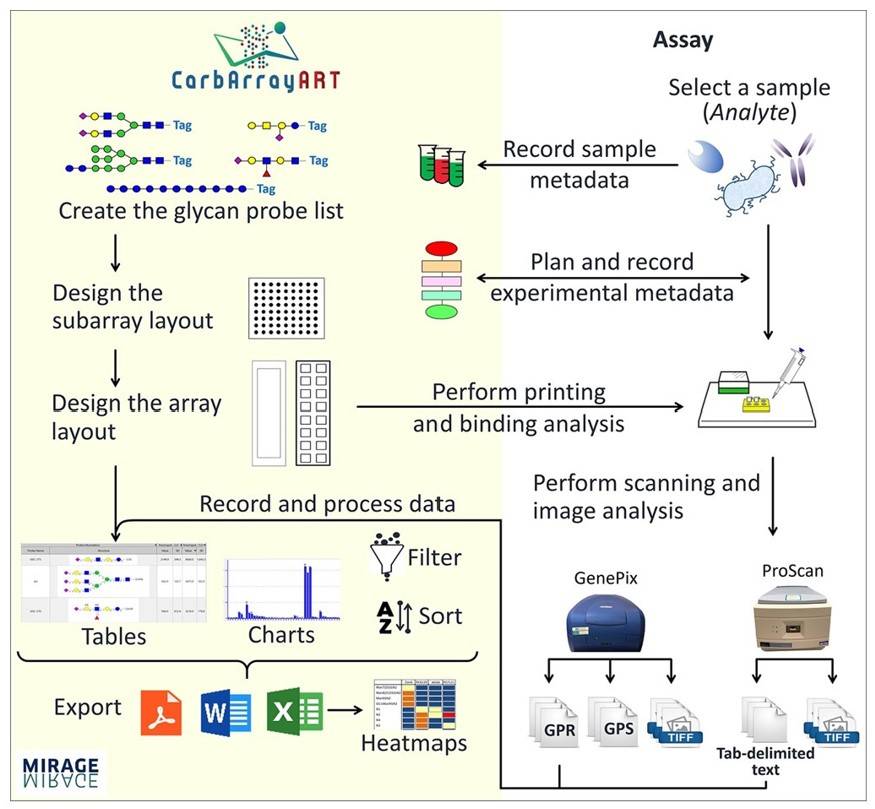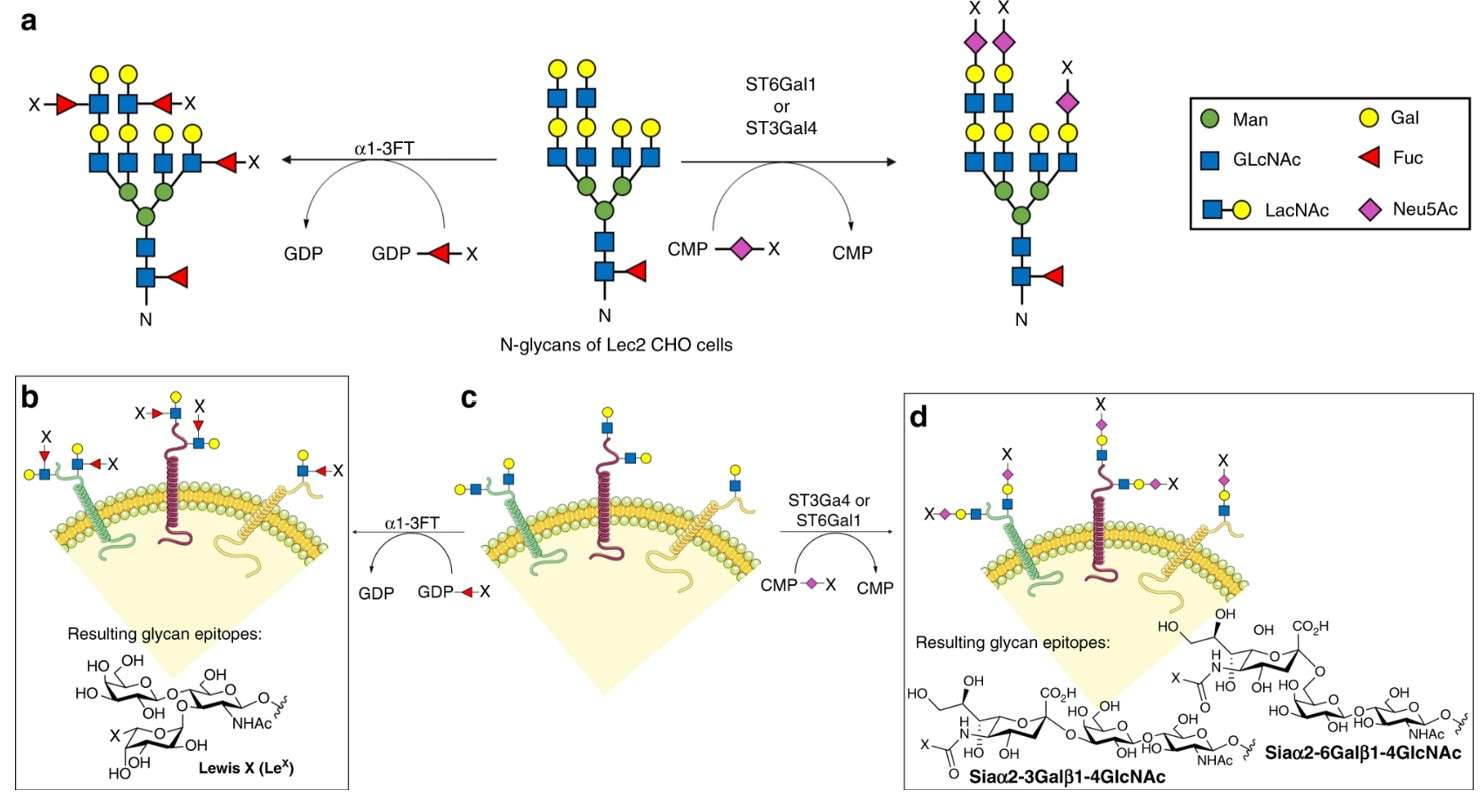Glycobiology Microarray
In the research of protein engineering, post-translational modification plays an important role in protein function, among which glycosylation is usually necessary for the biological activity of proteins. Therefore, the clear definiteness and detection of the carbohydrate-protein interactions lay a foundation to understand the action mode of functional proteins. Glycobiology microarray provides a powerful, high throughput approach to examining carbohydrate-protein interactions, and has a significant impact on the field of glycobiology. Creative Biolabs is a leading service provider that focuses on all kinds of protein studies. With years of experience in this area, we can provide a series of inexpensive and rapid glycobiology microarray services to match your protein glycosylation research.
 Fig.1 Clustered saccharide patches at different spatial scales.1, 4
Fig.1 Clustered saccharide patches at different spatial scales.1, 4
Introduction of Glycobiology Microarray
Detailed analyses of carbohydrate-protein interactions present difficulties at all levels because of limited amounts, structural diversity, synthesis difficulty and low affinity. However, several aspects of these challenges are now being addressed with the advent of glycobiology microarrays. Glycobiology microarrays, also referred to as carbohydrate microarrays or glycan microarrays, are composed of various oligosaccharides or polysaccharides immobilized on a solid support in a spatially defined arrangement. The main advantage of microarray analysis is that a broad range of glycans can be immobilized on solid matrices as minute spots and simultaneously interrogated. The multivalent display of arrayed saccharides can serve to mimic cell surface display and is ideal for detecting the generally very low affinities of interactions that involve carbohydrates. The miniaturization in microarrays is advantageous for making the most out of precious materials of both carbohydrates and protein analytes; and this, as well as the high-throughput feature of microarray technologies, is particularly well suited for investigations in glycomics, in which thousands of binding events can be assessed in parallel on a single chip containing tiny amounts of natural glycans.
What Can We Do?
The function of glycobiology microarray depends on the types of carbohydrate fixed on the chip, hence we provide various kinds of glycobiology microarray chips to match different requirements in glycoprotein research. Moreover, based on this established glycobiology microarray platform, we are able to offer many convenient glycoprotein-related services like Custom Synthesis, Glycoengineering Service, Glycoprotein Analysis, Anti-Glycoprotein Antibody Development, and Tumor Glyco-diag service.
 Fig.2 Schematic representation of the carbohydrate microarray analysis.2, 4
Fig.2 Schematic representation of the carbohydrate microarray analysis.2, 4
Through protracted and unremitting efforts, we have created a comprehensive glycobiology microarray platform consistent about 10 kinds of commercial glycans microassay as described below chips.
It is no doubt that glycobiology microarray approach has been advanced as a useful tool in the emerging field of glycomics. If you are interest in our glycobiology microarray technology or have any related requirement, please feel free to contact us.
Publication data
Glycan microarrays are a high-throughput analytical tool for glycan-binding protein-ligand interaction studies. This study describes a cost-effective and efficient cell-based glycan array construction method for probing glycan-binding protein-glycan interactions directly on the cell surface. The researchers mounted fucose, sialic acid, and their analogs on cell surface glycans to form a glycan array. By validating the utility of this cell-based glycan array, the results showed that a high-affinity glycan ligand for Siglec-15 was discovered using this array. This study not only provides us with an effective method for the construction of cell-based glycan arrays but also guides the application of glycan microarrays for detection.
 Fig.3 Construction of cell-based glycan arrays.3, 4
Fig.3 Construction of cell-based glycan arrays.3, 4
FAQs
Q1: How can glycan microarrays be used for tumor research?
A1: Glycan microarrays can be analyzed using a small amount of sample and trace amounts of glycans, making them an efficient tool for cancer diagnostic studies. It elucidates or suggests the role of structures, including glycans, in the development of cancer, and has been used to identify new biomarkers for cancer.
Q2: What information tools are available for analyzing glycan microarray data?
A2: A variety of tools for glycan microarray data have been developed or are under development, such as the following:
-
GlyGen microarray repository: This repository contains glycoinformatics data from multiple sources for storing and viewing glycan microarray data and associated metadata.
-
GlyMDB: It is a web-based database that links glycan microarrays from the Consortium for Functional Glycomics (CFG) database to protein structures.
-
GLYcan Array Dashboard (GLAD): It is a tool for visualizing, analyzing, comparing, and mining glycan array data.
Customer Review
Proven Glycobiology Microarray Technology
"Creative Biolabs utilized their glycobiology microarray to help us detect glycoprotein interactions. The microarrays they used contained a variety of glycans that met our interaction study needs. The data analysis provided was also very comprehensive, which helped us to interpret the results in depth. Their expertise and experience in glycobiology microarray were commendable."
Reliable Glycobiology Microarray Tool
"Creative Biolabs utilized glycobiology microarray technology to help advance our glycan-related research. Throughout the process, their team was responsive and comprehensive, helping us to efficiently identify novel glycan-binding proteins. There was no doubt that their service was top-notch, reliable, and recommended."
References
-
Cohen, Miriam. "Notable aspects of glycan-protein interactions." Biomolecules 5.3 (2015): 2056-2072.
-
Akune, Yukie, et al. "CarbArrayART: a new software tool for carbohydrate microarray data storage, processing, presentation, and reporting." Glycobiology 32.7 (2022): 552-555.
-
Briard, Jennie Grace, et al. "Cell-based glycan arrays for probing glycan–glycan binding protein interactions." Nature communications 9.1 (2018): 880.
-
Distributed under Open Access license CC BY 4.0, without modification.
For Research Use Only.
Related Services

 Fig.1 Clustered saccharide patches at different spatial scales.1, 4
Fig.1 Clustered saccharide patches at different spatial scales.1, 4 Fig.2 Schematic representation of the carbohydrate microarray analysis.2, 4
Fig.2 Schematic representation of the carbohydrate microarray analysis.2, 4 Fig.3 Construction of cell-based glycan arrays.3, 4
Fig.3 Construction of cell-based glycan arrays.3, 4



